Top Rankings
Leeds City School District ranks among the top 20% of public school district in Alabama for:
Category
Attribute
Diversity
Most diverse schools (Top 1%)
For the 2025 school year, there are 4 public schools serving 2,244 students in Leeds City School District. This district's average testing ranking is 5/10, which is in the bottom 50% of public schools in Alabama.
Public Schools in Leeds City School District have an average math proficiency score of 23% (versus the Alabama public school average of 27%), and reading proficiency score of 44% (versus the 47% statewide average).
Minority enrollment is 44% of the student body (majority Black), which is less than the Alabama public school average of 49% (majority Black).
Overview
This School District
This State (AL)
# Schools
4 Schools
1,520 Schools
# Students
2,244 Students
743,516 Students
# Teachers
120 Teachers
42,637 Teachers
Student : Teacher Ratio
19:1
19:1
District Rank
Leeds City School District, which is ranked within the bottom 50% of all 145 school districts in Alabama (based off of combined math and reading proficiency testing data) for the 2021-2022 school year.
The school district's graduation rate of 90-94% has decreased from 95% over five school years.
Overall District Rank
#77 out of 145 school districts
(Bottom 50%)
(Bottom 50%)
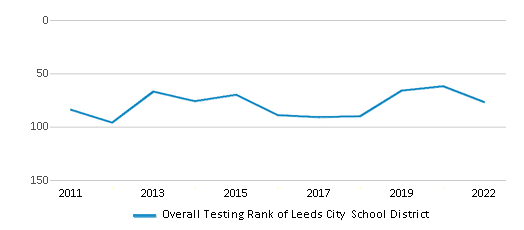
Math Test Scores (% Proficient)
23%
29%
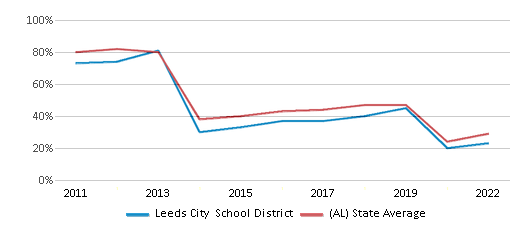
Reading/Language Arts Test Scores (% Proficient)
43%
47%
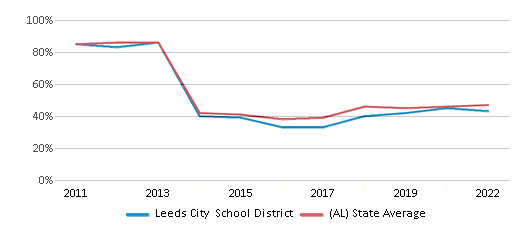
Science Test Scores (% Proficient)
32%
38%
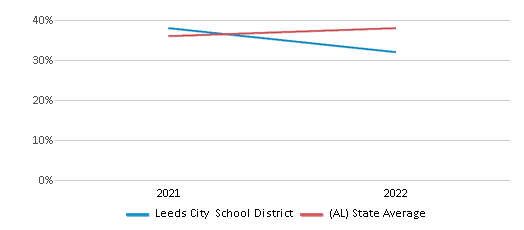
Graduation Rate
90-94%
88%
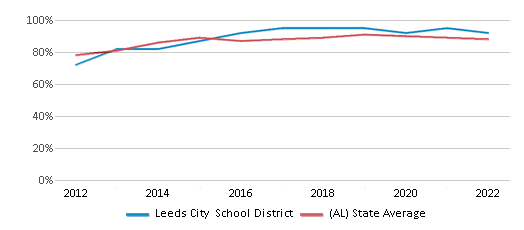
Students by Ethnicity:
Diversity Score
0.61
0.63
# American Indian Students
2 Students
5,986 Students
% American Indian Students
n/a
1%
# Asian Students
8 Students
10,976 Students
% Asian Students
n/a
1%
# Hispanic Students
352 Students
83,354 Students
% Hispanic Students
16%
11%
# Black Students
550 Students
234,256 Students
% Black Students
25%
32%
# White Students
1,255 Students
379,490 Students
% White Students
56%
51%
# Hawaiian Students
n/a
824 Students
% Hawaiian Students
n/a
n/a
# Two or more races Students
77 Students
28,630 Students
% of Two or more races Students
3%
4%
Students by Grade:
# Students in PK Grade:
153
21,953
# Students in K Grade:
192
55,899
# Students in 1st Grade:
184
58,528
# Students in 2nd Grade:
161
57,991
# Students in 3rd Grade:
173
55,161
# Students in 4th Grade:
155
54,236
# Students in 5th Grade:
146
54,179
# Students in 6th Grade:
159
54,861
# Students in 7th Grade:
152
55,768
# Students in 8th Grade:
150
56,376
# Students in 9th Grade:
165
59,139
# Students in 10th Grade:
146
56,986
# Students in 11th Grade:
162
53,181
# Students in 12th Grade:
146
49,258
# Ungraded Students:
-
-
District Revenue and Spending
The revenue/student of $13,991 is higher than the state median of $13,006. The school district revenue/student has declined by 6% over four school years.
The school district's spending/student of $10,731 is less than the state median of $12,220. The school district spending/student has declined by 6% over four school years.
Total Revenue
$31 MM
$9,671 MM
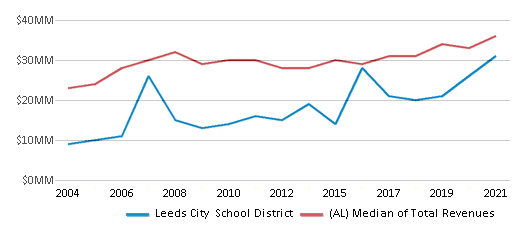
Spending
$24 MM
$9,086 MM
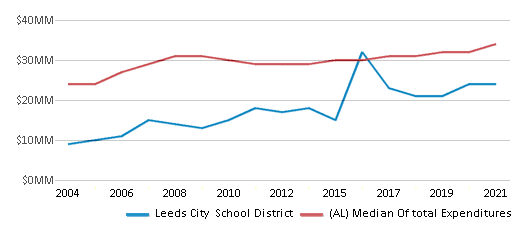
Revenue / Student
$13,991
$13,006
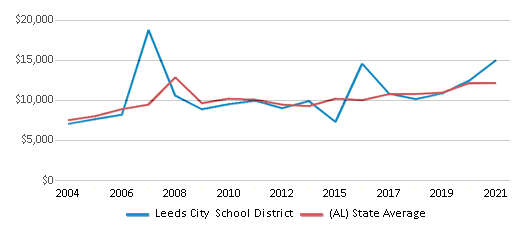
Spending / Student
$10,731
$12,220

Best Leeds City School District Public Schools (2025)
School
(Math and Reading Proficiency)
(Math and Reading Proficiency)
Location
Grades
Students
Rank: #11.
Leeds Elementary School
(Math: 32% | Reading: 46%)
Rank:
Rank:
7/
Top 50%10
950 Ashville Road
Leeds, AL 35094
(205) 699-4500
Leeds, AL 35094
(205) 699-4500
Grades: 2-5
| 635 students
Rank: #22.
Leeds Middle School
(Math: 17% | Reading: 45%)
Rank:
Rank:
5/
Bottom 50%10
1771 Whitmire Street
Leeds, AL 35094
(205) 699-4505
Leeds, AL 35094
(205) 699-4505
Grades: 6-8
| 461 students
Rank: #33.
Leeds High School
(Math: 15-19% | Reading: 30-34%)
Rank:
Rank:
4/
Bottom 50%10
1500 Greenwave Drive
Leeds, AL 35094
(205) 699-4510
Leeds, AL 35094
(205) 699-4510
Grades: 9-12
| 619 students
Rank: n/an/a
991 Park Drive
Leeds, AL 35094
(205) 702-4206
Leeds, AL 35094
(205) 702-4206
Grades: PK-1
| 529 students
Frequently Asked Questions
How many schools belong to Leeds City School District?
Leeds City School District manages 4 public schools serving 2,244 students.
What is the rank of Leeds City School District?
Leeds City School District is ranked #78 out of 145 school districts in Alabama (bottom 50%) based off of combined math and reading proficiency testing data for the 2021-2022 school year. This district ranks in the top 20% of Alabama school districts for: Most diverse schools (Top 1%)
What is the racial composition of students in Leeds City School District?
56% of Leeds City School District students are White, 25% of students are Black, 16% of students are Hispanic, and 3% of students are Two or more races.
What is the student/teacher ratio of Leeds City School District?
Leeds City School District has a student/teacher ratio of 19:1, which is higher than the Alabama state average of 17:1.
What is Leeds City School District's spending/student ratio?
The school district's spending/student of $10,731 is less than the state median of $12,220. The school district spending/student has declined by 6% over four school years.
Recent Articles

What Is A Charter School?
Explore the world of charter schools in this comprehensive guide. Learn about their history, how they operate, and the pros and cons of this educational innovation. Discover key facts about charter schools, including admission policies, demographics, and funding, as well as what to look for when considering a charter school for your child.

10 Reasons Why High School Sports Benefit Students
Discover the 10 compelling reasons why high school sports are beneficial for students. This comprehensive article explores how athletics enhance academic performance, foster personal growth, and develop crucial life skills. From improved fitness and time management to leadership development and community representation, learn why participating in high school sports can be a game-changer for students' overall success and well-being.

February 05, 2025
Understanding the U.S. Department of Education: Structure, Impact, and EvolutionWe explore how the Department of Education shapes American education, from its cabinet-level leadership to its impact on millions of students, written for general audiences seeking clarity on this vital institution.





